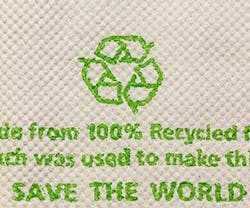7 Sustainable Options for Disposable Paper Products
Ever wonder how green those recycled brown paper towels really are?
Though easy to overlook, commercial tissue products are a simple way to promote environmental responsibility in your restrooms and kitchens. Take the opportunity to specify greener versions of cleaning supplies, facial tissues, and toilet paper.
No single attribute will make one product more eco-friendly than the next. Take a holistic view of environmental factors instead. Not sure what to look for? Here are seven criteria to consider for disposable paper products.
1) Recycled Content
While the EPA has guidelines for recommended levels for recycled content (see chart at right), none of them are mandatory. Evaluate a product’s ratio of post-consumer to post-industrial recycled content, says Mark Buckley, vice president of environmental affairs at Staples. The higher the post-consumer content the better because fewer natural resources have gone into the product.
Post-industrial (or pre-consumer) refers to scrap materials that are recycled from the manufacturing process, whereas post-consumer is waste derived at the end of the product’s lifecycle. It’s the difference between integrating donut holes into a new batch of dough vs. composting stale donuts instead of throwing them away.
2) Chlorine-Free
Think of the fumes from chlorine cleaning products and imagine the thousands of gallons required to bleach paper on an industrial scale.
“Chlorine and its derivatives like chlorine dioxide – the most common bleaching agents used by the pulp and paper industry – can be quite harmful to the environment,” says Bill Balek, director of environmental services with ISSA.
Look for the mark PCF (Processed Chlorine Free) or ECF (Elemental Chlorine Free), which are verified by the Chlorine Free Products Association.
3) Coreless Rolls
Does your janitorial staff capture the cardboard waste from toilet paper and hand towel rolls? While this material is easy to recycle, chances are it’s going directly into the trash.
Purchase coreless versions of paper products, says Buckley. When the core is eliminated, it reduces the raw materials required for cardboard rolls and glue.
This frees up more room for the paper product itself, which can increase time between dispenser refills. The smaller footprint also improves shipping efficiencies to reduce carbon impacts.PageBreak
4) Alternative Fibers
To conserve virgin timber, a new generation of plant materials is finding its way into disposable items.
“These alternative fibers come from bio-based sources such as bamboo, wheat, and sugar cane,” explains Garrett Gerst, senior marketing facility solutions for Unisource Worldwide, a supplier of paper, facility, and packaging products. “Companies are also turning to rapidly renewable sources like acacia and eucalyptus trees, which can be harvested in less than 10 years.”
5) Green Certifications
A third-party certification can validate claims of responsible forestry practices, chain of custody, and lifecycle standards, says Balek. Common certifications include the Sustainable Forestry Initiative (SFI), the Forestry Stewardship Council (FSC), ECOLOGO, and Green Seal.
6) Dispenser Efficiency
It’s too easy for users to blindly grab a wad of towels, so choose dispensers that encourage conservation.
Side-by-side toilet paper rolls, for example, can ensure partial rolls aren’t being thrown away, says Buckley. Folded towels can easily fall out of the dispenser and don’t offer any use restrictions. Use a dispenser with automated portion control or manual pull with a single release.
7) Packaging and Transportation
To get a complete and accurate picture of a product’s environmental impacts, it’s imperative to evaluate supply chain management, stresses Joan Monaco, development director with Ecoform, an environmental consulting firm.
It can be difficult to quantify the environmental impacts from shipping, so focus on packaging materials and how they affect your waste management practices.
“Several companies are now moving towards polyethylene bags over corrugated boxes,” Gerst explains. “The result has generally been better load efficiencies for transportation and less packaging volume.”
Switching to environmentally preferable paper products can ultimately improve your operations. Reduced waste and efficient product consumption can translate to lower purchasing costs, tipping fees, and labor needs – a home run for the environment and a win for your budget.
Jennie Morton is senior editor of BUILDINGS.
About the Author
Jennie Morton
A former BUILDINGS editor, Jennie Morton is a freelance writer specializing in commercial architecture, IoT and proptech.
